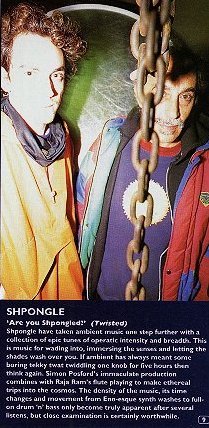

The following article was taken from WAX magazine, January 1999.
Simon Posford and Raja Rams' Shpongle collaboration is an expedition into the fifth generation of ambient. But it will satisfy everyone from your grandmother to those Spiral Tribe Freaks on 1,000 grammes of whizz. So they say. And Bertie Cairns seems to agree….
Mission accomplished. It is the day following the night before; midday, Sunday and that first cup of tea slips warmly soothing to the tips of your toes. Your head wallows in light and sound while your body aches from too much dancing, smoke and damp air. How do you feel? Would "Shpongled" fit the bill? This strange word caught the kerfuffled state of Simon Posford and Raja Ram's Glastonbury '95 and spawned a collaboration, an expedition into the fifth generation of ambient.
The result, three years later, is the album, "Are You Shpongled?" which is a collection of dubbed-up sonic excursions of epic proportions. Sounds have been swiped from as far apart as New Delhi market, the rain forests of Brazil and the wild life of Dorset.
"We find sounds that turn us on in the universe and put them in musical context. We aim to entertain ourselves. Ours is the bizarre, the weird, the wonderful. We aim for death by astonishment!"
You have been warned!

Tracks morph from formless, broad brush strokes and washes of sound, to the microscopic intricacies of drum and bass, where each 16th beat has a different effect applied to it. Raja's flute jams with Simons's synths, answering each other with melody and rhythm. Raja, in his usual effusive and referential way describes the result as "music for the shpongled generation".
They are clearly close friends. As the interview progressed, it was obvious that Raja knows how easily his word play takes control of a conversation - he samples phrases and then twisted them to his train of thought. He continually encourages Simon (who could hardly be described as shy) to volunteer information on the creative process and of their time in his Dorset studio. Their tales of shared experiences interweave, often with Raja expanding on Simon's thought, taking it to its cosmic conclusion.
Their creative process embraces every sense, like sensual addicts, they both relish every stimulation. "Before we start a track," explains Simon, "we get a visual idea of it. In "shponglefalls", after Raj had returned from Brazil, we imagined walking through the rain forest, the sunlight glinting in the pools. Then standing under the waterfall with the raw power of the water and then through the waterfall into the silence of the cave with the stalagmites."
Then Raja picks up the thought, like a winger receiving a rugby ball and dives for the try line; describing the silence as, "one drip taking up the whole of infinity rather than the rush of the noise before."
Raja and Simon continue using elaborate metaphors when working out how to manipulate their sounds. When they get their hands into this sonic recipe, the music became physical. "We use visual food terms - not technical terms like minor sevenths. Instead, we talk of needing, "more souffle, more sausage meat! Imagine 1000 jelly fish tentacles sending hallucinations into your third eye."
Shpongle take you places, playing with contrast and tension, with space and density. They create tensions that are not possible with the rigorous rules of any dance floor. Raja describes the feeling as, "more air and space and time to reflect in music, which gives the relaxation between the tension." The joy of ambient tracks is that you don't have to have a hammering beat coming in a few bars after a break down has begun.
Describing Shpongle as ambient might be a bit misleading. While this album is perfectly good as wall paper music, it is flush with melodies and ideas, often challenging and never repetitive. It's last track is an extraordinary example of music dynamism controlled over 20 minutes. If you think ambient is a very stoned bloke with his finger on a single note for three nd a half hours, thing again.
Tracks are layered and complex. They change time signatures to create a feeling of breaking through to the other side - imitating the psychedelic moment when things have suddenly gone out of control. They combine with high tek with acoustic. The flute, for Raja, "is the multi orgasmic voice of the angels and it is a formidable combination with the array of electronics."
They aim for a sense of flowing improvisation over computer programming. Simon's immaculate skills with technology actually allow the electronic side of the sound to appear fluid and loose despite the digital format. They have not been seduced by the ease with which electronic music can sound good with gradually modulating repetition.
"Listen to classical music, its not seven little smart things: let's get cosmic!" Says Raja. "Lets get on the gigantic flow, the symphonic part without being pretentious, look at it in a vast, more operatic way."
They believe music needs to have a dignity and quality which will allow you to play it, "to your grandmother or to some Spiral Tribe Freak on 8000 packets of whizz. It has something for everyone on a level. We're just talking about a little capsule of something we've brought back from another planet, planted on a silver disk and just pressed play - it'll take you away for a while.
Shpongled or what?